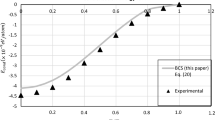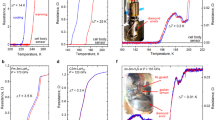Abstract
After a brief summary of the historical development of the field of superconductivity and the background required for the topics treated in the present paper, some of the relationships between superconductivity and physical metallurgy are discussed. These are mainly in two areas: i) The distribution of magnetic flux in super conductors may show fine structures (boundaries between normal and superconducting regions in the intermediate state of type-I superconductors; quantized flux-lines in the Shubnikov phase of type-II superconductors) on such a scale that they interact strongly with the metallurgical microstructure of the superconducting materials, such as grain boundaries, dislocations, precipitates, and so forth. ii) Ideally, the flux-lines in a type-II superconductor form a two-dimensional lattice (Abrikosov lattice). The decoration technique of Träuble and Essmann has permitted the direct observation of these flux-lines lattices and has revealed that they contain a rather high density of defects. Most of them are known from the studies of defects in crystals, such as grain boundaries, dislocations, stacking faults, and vacancy and interstitial lines, but also disclinations, which were predicted by theory but have not yet been observed in metals, were investigated.
Similar content being viewed by others
References
H. Kamerlingh-Onnes:Commun. Phys. Lab. Univ. Leiden, 1911, no. 122b.
H. Kamerlingh-Onnes:Commun. Phys. Lab. Univ. Leiden, 1913, Suppl. no. 34.
F. B. Silsbee:J. Wash. Acad. Sci., 1916, vol. 6, p. 597.
W. Meissner and R. Ochsenfeld:Naturwissenschaften, 1933, vol. 21, p. 787.
J. Bardeen, L. N. Cooper, and J. R. Schrieffer:Phys. Rev., 1957, vol. 108, p. 1175.
W. J. de Haas and J. Voogd:Commun. Phys. Lab. Univ. Leiden, 1930, no. 208b.
L. V. Shubnikov, V. I. Khotkevich, Yu. D. Shepelev, and Yu. N. Riabinin:Phys. Z. Sowjet., 1936, vol. 10, p. 165.
V. L. Ginzburg and L. D. Landau:Zh. Eksperim. i. Teor. Fiz., 1950, vol. 20, p. 1064; English translation, e.g., in: Collected Papers of L. D. Landau, D. ter Haar, ed., pp. 546–68, Gordon and Breach, New York-London-Paris, 1965.
A. A. Abrikosov:Sov. Phys. JETP, 1957, vol. 5, p. 1174.
W. Klose,Phys. Letters, 1964, vol. 8, p. 12.
H. Träuble and U. Essmann:Phys. Stat. Sol., 1966, vol. 18, p. 813.
H. Träuble and U. Essmann:Jahrbuch der Akademie der Wissenschaften zu Göttingen, pp. 19–30, Vandenhoeck and Ruprecht, Göttingen, 1967.
U. Essmann and H. Träuble:Phys. Letters, 1967, vol. 24A, p. 526.
H. Träuble and U. Essmann:J. Appl. Phys., 1968, vol. 39, p. 4052.
U. Essmann and H. Träuble:Phys. Stat. Sol., 1969, vol. 32, p. 337.
D. Cribier, B. Jacrot, L. Madhay Rao, and B. Farnoux:Phys. Letters, 1964, vol. 9, p. 106.
B. Obst:Phys. Letters, 1969, vol. 28A, p. 662.
U. Essmann: Intern. Conf. Science of Superconductivity, Stanford, 1969.
R. Labusch:Phys. Letters, 1969, vol. 22, p. 9.
E. H. Brandt:Phys. Stat. Sol., 1969, vol. 35, p. 1027.
E. H. Brandt:Phys. Stat. Sol., 1969, vol. 36, p. 371.
E. H. Brandt:Phys. Stat. Sol., 1969, vol. 36, p. 381.
E. H. Brandt:Phys. Stat. Sol., 1969, vol. 36, p. 393.
D. C. Hill, D. D. Marrison, and R. M. Rose:J. Appl. Phys., 1969, vol. 40, p. 5160.
J. D. Livingston and H. W. Schadler:Progr. Mater. Sci., 1964, vol. 12, p. 183.
D. Dew-Hughes:Mater. Sci. Eng., 1966, vol. 1, p. 2.
P. Haasen:Z. Metallk., 1969, vol. 60, p. 149.
H. Ullmaier:Festkörperprobleme, 1970, vol. X, p. 367.
B. Goodman:IBM J. Res. Develop., 1962, vol. 6, p. 63.
A. Seeger and H. Kronmüller:Phys. Stat. Sol., 1968, vol. 27, p. 371.
H. Kronmüller and A. Seeger:Phys. Stat. Sol., 1969, vol. 34, p. 781.
W. F. Brown, Jr.:Micromagnetics, John Wiley & Sons (Interscience), New York, 1963.
H. Kronmüller:Phys. Stat. Sol., 1970, vol. 40, p. 295.
U. Kammerer:Z. Physik, 1969, vol. 227, p. 125.
U. Kammerer:Phys. Stat. Sol., 1969, vol. 34, p. 81.
J. Petermann: Ph.D. thesis, University of Göttingen, 1970.
H. Freyhardt: Ph.D. thesis, University of Göttingen, 1970;Phil. Mag., to be published.
Author information
Authors and Affiliations
Additional information
Dr. SEEGER studied Physics at the University of Stuttgart from 1946 to 1950, and he received his PhD (Dr. rer. nat.) in 1951. From 1951 to 1952 he served at the University of Bristol and in 1955 at the University of Cambridge (England). In 1956, he was appointed a division head at the Max-Planck-Institut, and in 1965, was appointed director of the Physics Department. Since 1959 he has been a Professor of Solid State Physics at the University of Stuttgart, and he holds a joint appointment at both the University and the Max-Planck-Institut at the present time.
Dr. SEEGER has done research in theoretical physics, solid state physics, and materials science, in particular on defects in crystals, electronic structure of metals, ferromagnetism, and superconductivity. He is a member of the editorial or advisory boards of several scientific journals.
Rights and permissions
About this article
Cite this article
Seeger, A. Superconductivity and physical metallurgy. Metall Trans 1, 2987–2996 (1970). https://doi.org/10.1007/BF03038411
Issue Date:
DOI: https://doi.org/10.1007/BF03038411




